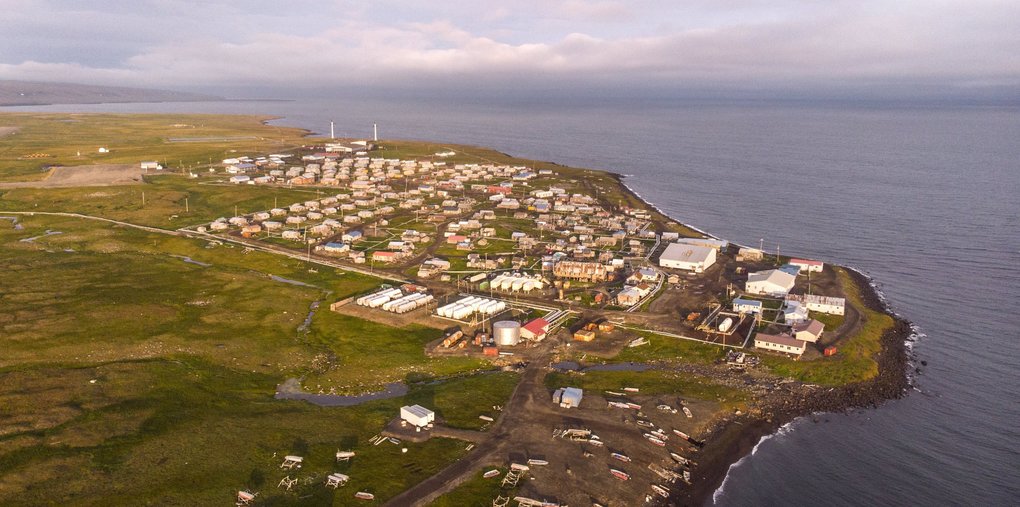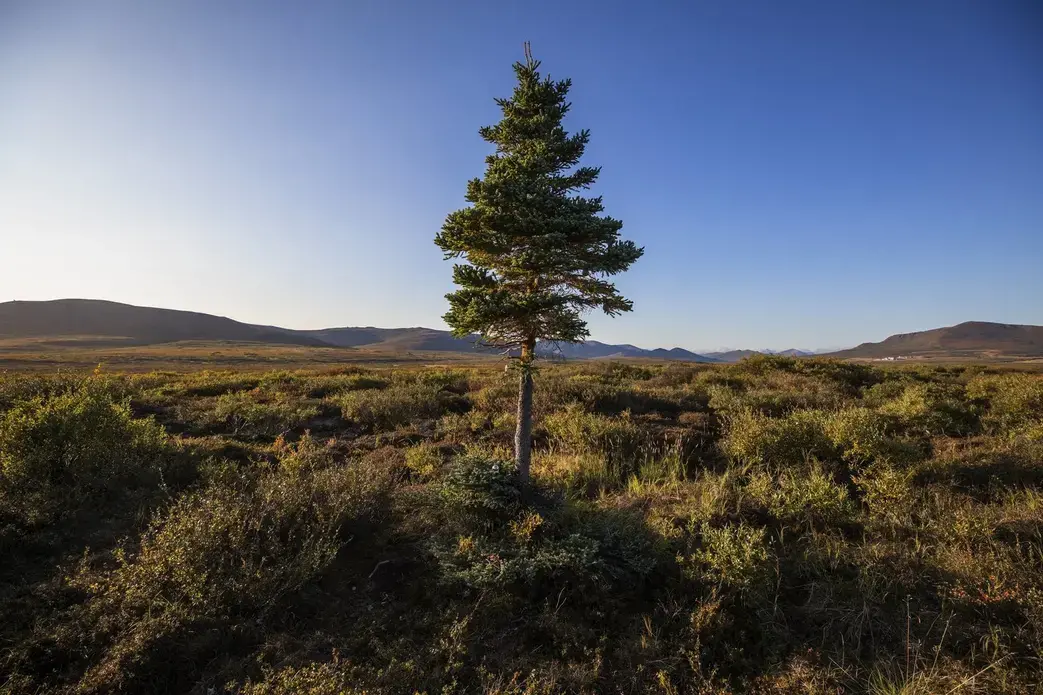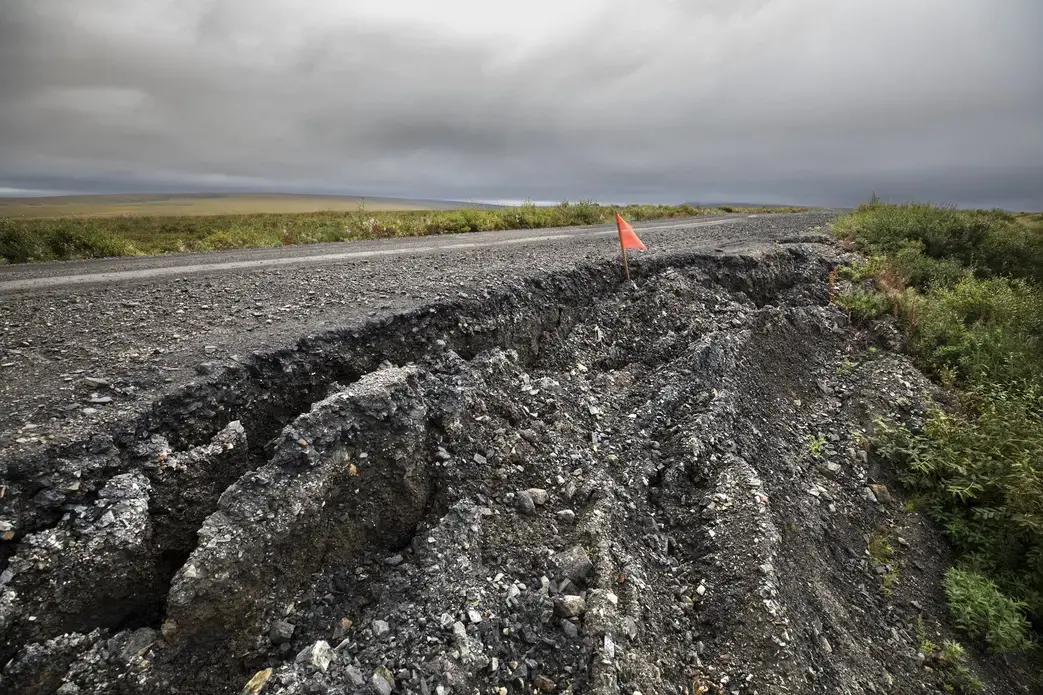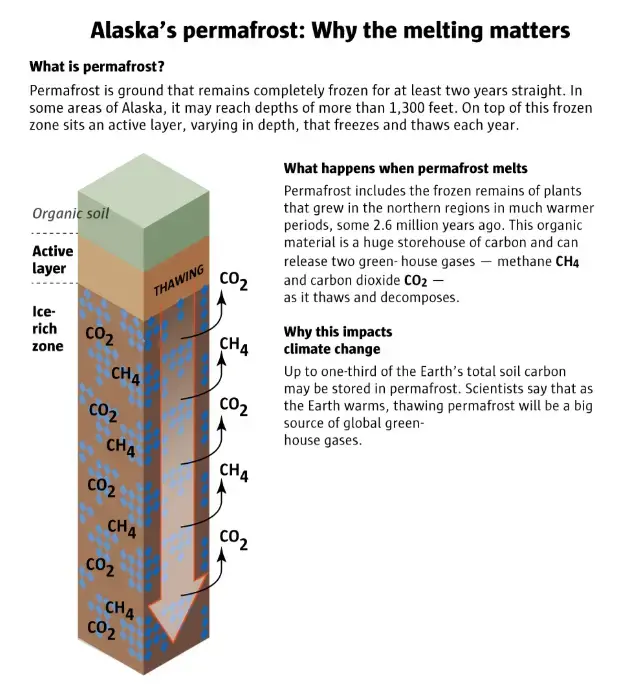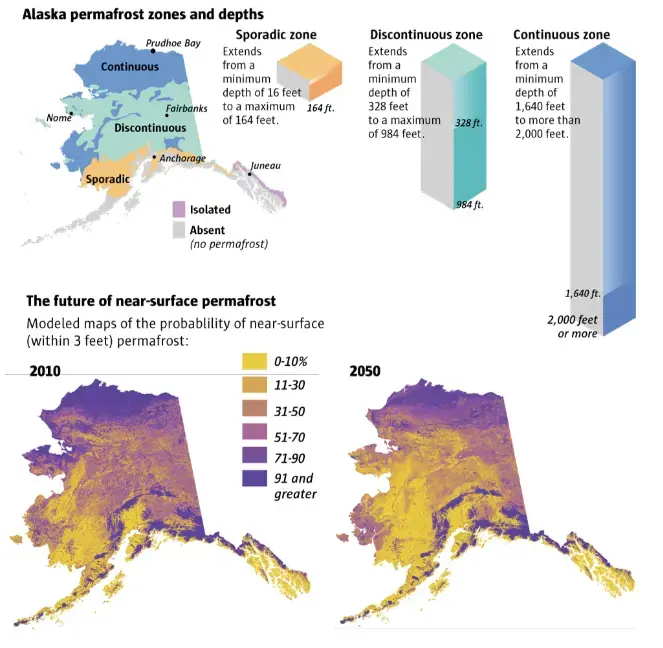
TELLER, Alaska — An unpaved highway runs north out of Nome, carving through more than 70 lonely miles of tundra before dead-ending at this Inupiaq village.
Maintenance crews keep the route open during the summer months. The work has become increasingly costly as a layer of ice and frozen dirt under the road softens into soggy muck, and stretches of road bed crack and collapse.
“There is so much melting. We just keep having to haul in gravel,” said Calvin Schaeffer, of the Alaska state Department of Transportation.
Alaska’s permafrost is under assault from a warming climate, and it’s happening a lot faster than anticipated. Hillside slopes have liquefied, unleashing slides that end up as muddy deltas in salmon streams. The ground under the Nome airport runway — key to linking the community to the outside world — has thawed, requiring costly patches. And during the hottest July on record, a sinkhole 14 feet deep opened along a main roadway in the city.
For a region where climate change also is bringing profound changes offshore, these are disruptive developments. As the northern Bering Sea warms, bird and marine mammal die-offs are on the rise and winter ice is on the decline, enabling storms to gain strength over open water and slam into coastal communities like Teller.
The accelerating melt is a global concern: Permafrost, which mostly lies in the northern reaches of the planet, is a vast carbon storehouse of frozen plants and animals that release greenhouse gases as they warm and decompose.
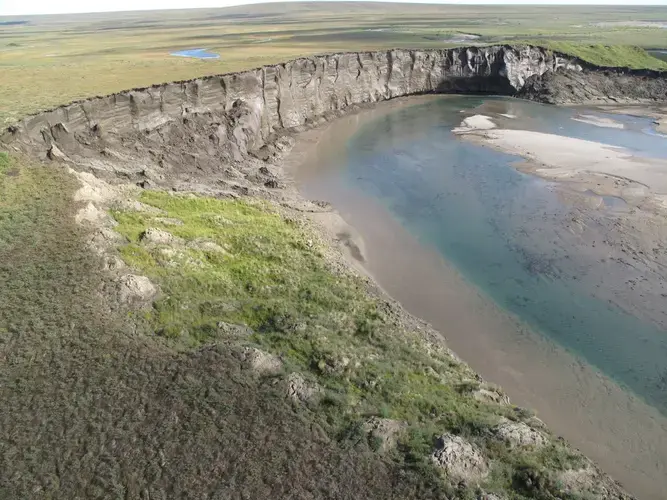
Fossil-fuel combustion still is the main source of greenhouse-gas emissions driving climate change. But the world’s permafrost now releases 1.2 to 2.2 million metric tons each year — at the upper end, nearly equal to Japan’s greenhouse-gas emissions, according to a report this month by the National Oceanic and Atmospheric Administration. Later this century, these emissions are expected to exceed those of the United States.
Scientists who study permafrost already are noticing some striking changes in Alaska’s landscape.
Canadian scientist Merritt Turetsky monitors tracts of interior Alaska permafrost that a decade ago were covered by spruce forest. That land is now covered with lakes.
“It can happen super-quickly, even in a matter of months … This has been a wake-up call to the climate-science community,” Turetsky said. “What has been happening at some of our field sites is a whole different ballgame."
Ground Sags, Structures Tilt
Permafrost’s footprint on Alaska is forecast to shrink substantially in the decades ahead. By the century’s end, even on Alaska’s North Slope, the ground is expected to thaw 65 feet down, according to University of Alaska Fairbanks research.
This reflects what scientists say is a critical shift in the planet’s northern realms. In the past, permafrost regions, on balance, absorbed carbon dioxide through summer plant growth. But the NOAA report noted that northern regions are now a net contributor to greenhouse-gas emissions as the permafrost thaw quickens.
In Alaska, the permafrost retreat requires a fundamental rethinking of the fate of things built on top of it.
Oil pipelines, drilling pads and other structures will need to be shored up as ice-rich permafrost melts and the ground sags. In towns such as Nome, the changes in permafrost already pose a headache for homeowners, who must level house foundations that tilt as the climate warms.
And how much will it cost to maintain Alaska’s roads, bridges and airports — and how long will they last? Some, if built on permafrost that is mostly ice, could suffer catastrophic failures.
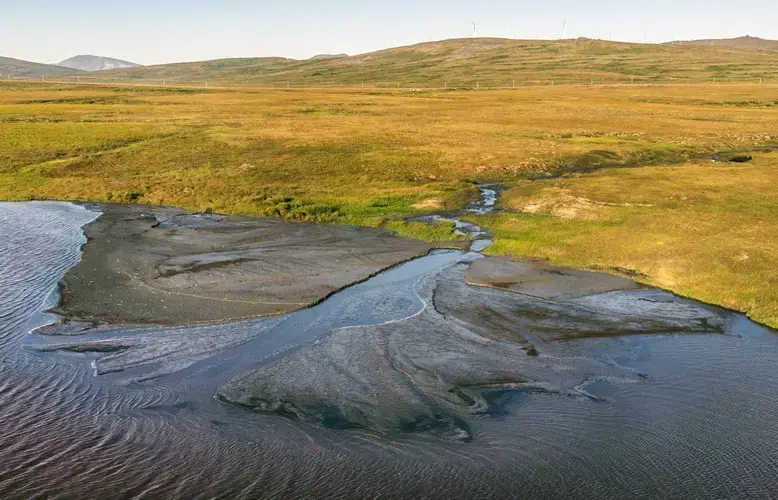
“The big thing to me is the life span of these projects,” said Jeff Currey, a state transportation department materials engineer. “The permafrost reality, in some places where you have massive ice, the roads … disappear. And that’s something that we have a hard time grasping.”
Some permafrost is largely gravel, so there’s not much movement when it melts. Some is a mix of ice and soil, a kind of landscape glue that, once warmed, can cause hillsides to come apart. Some permafrost consists of nearly pure ice wedges that leave behind big depressions when they turn into water.
Charlie Lean, a retired fishery biologist raised in Nome, says the changes can be startling.
On a moose hunt, he found a river that once flowed clear was running cloudy because of glacial silt picked up by meltwater from the permafrost. In places once dominated by shrubs, cottonwoods — which die if their roots freeze — have found enough continually thawed soil to sometimes grow into 6-foot trees.
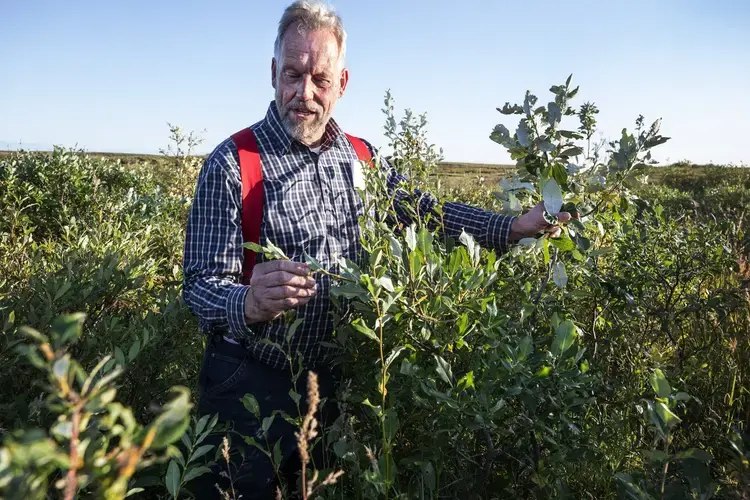
Just walking across some stretches of ground can be a different experience from his youth.
“It’s getting lots of hummocks and little rivulets, and it’s much rougher,” Lean said.
Vladimir Romanovsky, geophysicist at the University of Alaska Fairbanks, says the pace of the thawing in Northwest Alaska appears to have quickened during the past half decade, which has included intense summer rains that can soften the ground, as well as a dry spell this past summer that included tundra fires.
In some places, shallow layers of permafrost have disappeared. In others, the ground could continue to sink for decades, continually destabilizing whatever is built up top.
“It’s a long process, and a painful process,” Romanovsky said.
Over the summer, the Alaska state Department of Transportation spent $4.5 million repairing the Nome runway, which was built in a hurry during World War II on permafrost terrain that is now settling in a process aggravated by groundwater seeping from a nearby river. The fix is expected to last three to five years as the ground continues to settle.
“The Ground Just Caved”
Coastal villages face a triple threat: rising sea levels, a loss of winter ice that once helped protect them from storms, and thawing permafrost.
“The tundra where we have been picking (berries) for the past 20 years — the ground just caved and my leg sank in,” said Denise Topkok, a council member in Teller. The village, born more than a century ago as a gold-rush boom town, is now a Native community of about 235 people.
The sea is eroding a protective coastal bluff of softening soil, threatening a cemetery where the grave markers already lean at sharp angles due to the warming ground.
In the low-lying area, the sea is held at bay by a makeshift wall of gravel-filled oil drums and an assortment of rusting engine blocks, truck axles and other equipment. But it’s not sufficient. Teller has suffered repeated flooding.
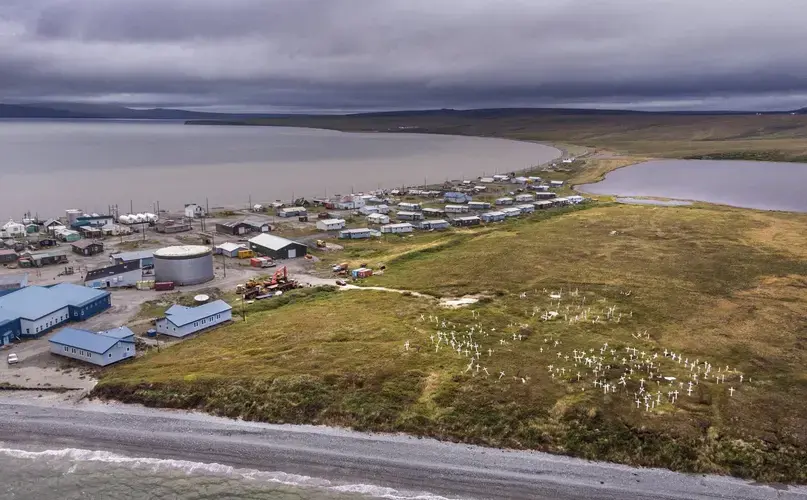
Through the years, more than 30 houses have been built on higher ground, and more families would like to relocate there.
Teller is one of 31 Alaska villages listed in a Government Accountability Office report as “imminently threatened by flooding and erosion.”
Some of these villages are in more dire straits. There is keen competition for federal funds, and Alaska is having new money troubles. State government is largely funded by taxes and royalties on oil production, which has been in long-term decline. Oil production in 2018 was down 75% from a 1988 peak.
To cope with financial shortfalls, Republican Gov. Mike Dunleavy, a former school administrator from Northwest Alaska, has slashed state budgets and declined to dip into a more than $64 billion oil-wealth savings account — known as the Permanent Fund — that kicks out dividends to every Alaska resident.
The scope of Dunleavy’s cuts has stirred a fierce political backlash, including a recall petition now the focal point of a court battle.
Over the long term, Dunleavy, a staunch ally of President Donald Trump, is hoping for major new oil finds in North Slope areas such as the Arctic National Wildlife Refuge that Congress in 2017 opened for oil exploration. Even with climate-change costs mounting, there is plenty of support for such an industry expansion in a state that has long been a Republican stronghold. But more Alaskans now acknowledge the impacts of fossil-fuel development.
“Maybe Al Gore was right about climate change,” said Darrin Otton, manager of the Nome Airport.
“And we’ve got to get Donald Trump to make a trip up here,” responded Schaeffer, the road-maintenance supervisor.
Dunleavy believes “there is no question” Alaska is warming, and that “carbon dioxide emissions may hold a key,” according to a statement to The Seattle Times. But he does not think it is “feasible or practical” to end oil and gas production and, in September remarks reported by the Juneau Empire, he talked of the benefits of climate change, such as increased maritime trade through northern waters once clogged with ice.
A Perilous Trek
Nome has seen a surge of maritime traffic. Since 2007, the annual number of vessels docking at the port has more than tripled. This year, a record 13 cruise ships dropped anchor, disgorging hundreds of passengers for brief tours of Nome’s fabled main street, the end point for the Iditarod Trail Sled Dog Race.
Nome also is a port of call for sailors pulled north in hopes of navigating the Northeast Passage that runs through Arctic waters off Russia to Europe, or the Northwest Passage that runs through Canadian waters to the Atlantic.
In August, a berth inside the breakwater was claimed by the Pangaea, a slender 105-foot sailboat with a hull fortified to push through ice.
The boat is owned by Mike Horn, a South African-born explorer who has made marathon expeditions all over the globe, including a 2006 ski journey from Russia to the North Pole in the company of Norwegian Børge Ousland.
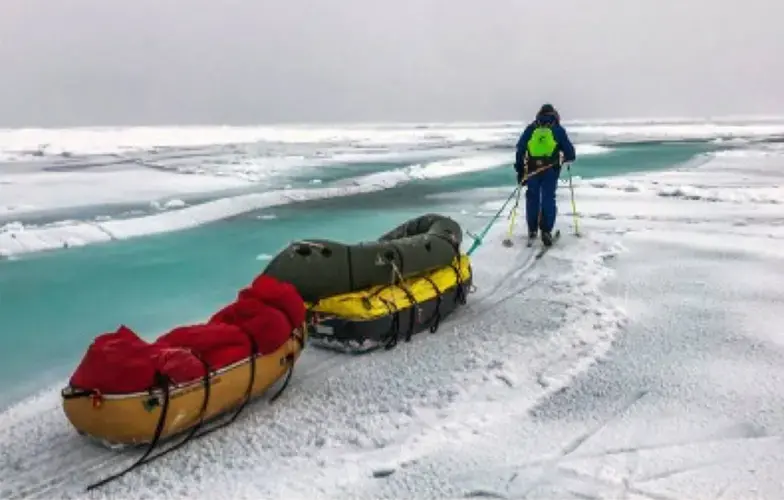
This year, Horn and Ousland reunited in Nome, taking on supplies and some fresh young crew and making repairs as they prepared to attempt a bold new trek.
They planned for the Pangaea to push hundreds of miles north on a route made possible by diminished Arctic ice. The two men would exit the boat to ski to the North Pole, then head toward to the Norwegian island of Spitsbergen, where the Pangaea — after a voyage through waters off Russia would be waiting.
Horn estimated the trip would span nearly 1,000 miles.
“The conditions are favorable for us,” Horne said in an Aug. 22 Nome interview in the Pangaea’s cabin. “We’ve got a very good chance.”
In late September, the Pangaea reached 85 degrees North, and the two men began their odyssey. They skied to the North Pole, and then slogged toward Norway. They fell short of skiing to the Pangaea, but on Dec. 8 — the day of their last food ration — they reached the safety of the Lance, a Norwegian polar research vessel, where they enjoyed a meal of spinach soup, steak and chocolate.
Along the way they battled frostbite and unstable, thin and rapidly drifting ice, a big change from the thicker, more stable ice they encountered through much of their 2006 trek. They often had to strip off their skis and climb into small inflatable rafts to cross open leads of water. Several times, they broke through thin ice, partially submerging their bodies in frigid water in what Horn in his Instagram posts described as a disturbing look at a changing Arctic climate.
“It is a hostile world up here,” Horn wrote in a Nov. 25 passage posted on Instagram. “One thing is certain, something is obviously not quite right.”



